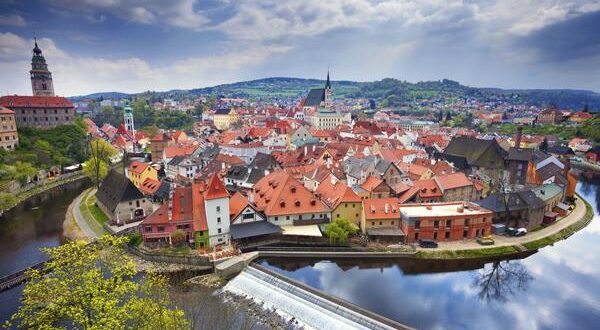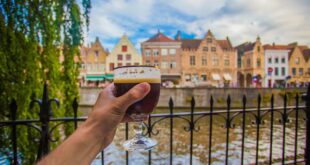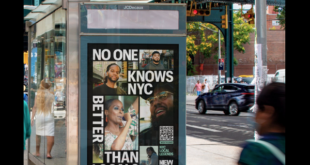[ad_1]
Did you know that Czech wine is winning awards? Or that if you’re visiting on November 11th, you might be treated to a traditional feast of roasted goose?
Whether you’re a travel advisor or travel lover (or both!), you’re bound to learn a few new things about this Central European country in this interview with Michaela Claudino, Director of CzechTourism USA & Canada. We cover lots of different aspects of travel in the Czech Republic, a celebrated-yet-still-underrated destination that should be on everyone’s European trip radar.
Scott Hartbeck (SH): What is the one thing someone should know about the Czech Republic before they visit?
Michaela Claudino (MC): Czech Republic is incredibly diverse given the size of the country (roughly the size of South Carolina). We have 16 UNESCO World Heritage sites, more than 2,000 castles and chateaux, over 30 spa towns but also great outdoors – with more than 25,000 miles of hiking and biking trails. But you asked me about one thing only, right? Then don’t say “Czechoslovakia” and don’t call us Eastern Europe anymore 🙂 !
SH: What is new in the Czech Republic that we should know about?
MC: There are some new hotel developments mainly in Prague. During the pandemic, many hotels invested their time and money into refurbishing their properties.
Marriott Hotel Prague’s refurbishment and expansion has added 123 new rooms and suites to the hotel, taking the total number up to 416. Many of the new rooms feature balconies and terraces allowing guests to enjoy views of the old town spires. Marriott’s transformation also includes a new signature restaurant: The Artisan – a modern, sustainable Czech culinary experience using high-quality local produce and fresh seasonal ingredients including herbs grown in the restaurant’s own “urban cultivator” and an open plan “theatre kitchen”.
There will be also a few new five-star hotels opening such as the Hyatt’s Andaz Hotel Prague which is accepting reservations from March 2022. A luxury lifestyle hotel, Andaz Prague is located on Senovázné Square, in the heart of the historical center of Prague. There are only four Andaz Hotels by Hyatt in Europe – in Vienna, Munich, London and Amsterdam. Prague will be the fifth.
W Hotels Worldwide also plans to open in Prague in the former Art Nouveau Grand Europa Hotel on Wenceslas Square. The opening has been delayed because of the pandemic, but most likely in the second half of 2022.
And last but not least, the former Intercontinental Hotel in Prague is undergoing a complete gut renovation and will become the new Golden Prague Hotel managed by Fairmont. The renovations are planned until the
end of 2022.
Some new additions in 2023 might include the Hotel Alaman, Ritz Carlton, or Hard Rock Hotel in Letna.
SH: As this is autumn, is there anywhere in the Czech Republic that is especially well known for having pretty fall foliage?
MC: Many people don’t realize it, but Prague is one of the greenest cities in Europe and even in the world. Grassy and wooded areas make up 56 percent of the city’s area so you can easily visit one of the many parks and see the foliage right in the city. The most popular parks include Petrín, Letná, Divoká šárka, and Stromovka.
As mentioned before, Czechs are avid hikers and the Czech Republic has over 25,000 miles of color-coded, marked trails. If you want to stay closer to Prague, visit the area of Bohemian Switzerland – just one hour north of Prague. If you have more time head to the Eastern part of the Czech Republic, called Moravia and explore some of the renowned vineyards.
Another great way of enjoying the fall foliage and panoramic views would be climbing up some of the treetop walkways in Krkonose mountains, South Bohemia or Central Moravia.
SH: The Czech Republic is famous for its sensational beer, but Czech wine is also worth checking out, isn’t it? Is there one variety/vineyard you would recommend to a first-time Czech wine drinker?
MC: The Czech Republic has two wine regions – Bohemia and Moravia. Bohemia is an area nearer to Prague, and only produces 5-10% of the country’s wine.
Moravia is in the southeastern part of the country, bordering Austria, and produces 90-95% of the wines from Czech Republic. Moravian wines are considered a national treasure and have been recognized with silver and gold medals by wine judges from all over the world. Just recently the Moravian Pinot Noir won the world’s best title at the prestigious international competition “Mondial des Pinots”. Generally speaking – white wine is gaining more recognition than red ones. Among the top grapes are:art Muller-Thurgau, Gruner Veltliner, Welschriesling, (Rhine) Riesling, Sauvignon Blanc, Pinot Blanc, & Chardonnay. We also produce less than we drink, so the only way you can sample the delicious wines of Moravia might be a trip to visit the region personally!
SH: If I want the best experience in the Czech great outdoors, where am I going and why?
MC: Are you a biker or hiker or both? Do you like mountains or rather rolling hills and ponds? Czech countryside is very picturesque. you can explore caves and rock cities, climb to the tops of mountains and observation points! Places you will never forget and where you will always be happy to go back to – such as the fairy-tale landscape of the Bohemian Switzerland National Park, the gorges of the Adršpach Rock City or Punkevní Cave in the Moravian Karst. The cold northern character is exuded from the shadows of Boubín Forest in šumava, while you will be surprised by the warm, almost Mediterranean character of the landscape in the Palava Bio Reserve. Czech Republic has more than 25,000 miles of marked hiking trails so take your pick!
SH: For travelers who enjoy timing their trips with festivals and special events, what would be a Czech festival event that everyone should experience once in their lifetime?
MC: That is a tough question… it really depends on your personal preference and interest, but generally speaking I would say anything related to music.
Every year, Prague hosts a world-known international classical music festival – Prague Spring which takes place in one of the most beautiful Art Nouveau buildings in Prague (the Municipal House), but we also have a festival called Colors of Ostrava – a multi-genre music festival, one of the largest in Central Europe. The festival takes place in the very unique setting of Dolní Vítkovice – a place that served as a center of black coal mining and production of raw steel between the years 1828 and 1998.
We have some traditional folkloric festivals such as the Ride of the Kings in Moravia – a 200-year-old tradition that is included in the UNESCO intangible cultural heritage list. This parade is a colorful, ceremonious horseback procession of boys in traditional folk costumes and takes place in May in a small village called Vlcnov in Moravia.
For those who are not into traditions & folklore and are looking for something more contemporary, I would recommend visiting a festival that introduces young designers and artists, called Design Blok. The Prague International Design Festival is the biggest selective festival of design and fashion in Central Europe. Designblok showcases the work of designers and manufacturers with an emphasis on Central Europe and presents new products from prestigious Czech brands as well as prototypes from young designers and design studios.
SH: The last time I was in the Czech Republic, I visited at Christmas and I absolutely loved it. What do you think is the best thing about winter and offseason travel in the Czech Republic?
MC: The simple answer is fewer crowds (although that is relative now), off-season prices and although you might not be to spend so much time outside due to colder weather, you can take in all the cultural offerings.
Fall is usually a great time to visit as you can still catch some of the wine festivals in September. In October it gets a bit cooler, but it is still a great time to see some of the foliage we talked about before and take in some culture – such as the Signal Festival – video mapping throughout the city of Prague. In November, the Czech Republic celebrates St. Martin’s Day. According to Czech folklore, St. Martin arrives in early November on a white horse, signifying the first snowfall of the year. Celebrations include the sampling of young wines and a traditional feast of roasted goose, which is served in most Czech restaurants with a side of red cabbage and dumplings.
By mid-November, winter begins to creep in and according to traditional Czech lore, it is bad luck if the mountains haven’t gotten their first snowfall by November 11th, St. Martin’s Day. If you don’t mind the cold, December may be the most beautiful, and best time of year to visit Prague. Christmas in Prague is magical!
The most popular and largest markets are traditionally held on Old Town Square, which becomes the main center of pre-Christmas celebrations. Dominated by a huge Christmas tree selected each year from a different
region of the Czech Republic, the market is visited by thousands of people every winter. Mulled wine, excellent sausages, and bratwurst. In addition, they can admire a display of traditional arts and crafts, such as sword making, or enjoy the extensive additional program while listening to the sound of Christmas carols. This year, the markets will officially be open to the public on Wenceslas Square and Old Town Square from Saturday, November 27th to Thursday, January 6th.
SH: Whenever you return to the Czech Republic, what is the one meal you have right away?
MC: I have a sweet tooth and love Czech pastry, so my first steps always lead to a good bakery.
I love kolace – Czech pastries made of a yeast dough and usually filled with fruit, but sometimes cheese with toppings such as poppy seed (my favorite), apricot or prune. By the way – did you know that the Czech Republic is one of the world’s largest producers of poppy seeds in the world?
I also like fruit dumplings, especially in the summer. Speaking of dumplings – there are many different types and varieties and they are mostly savory and served with traditional dishes such as the roasted duck with sauerkraut or svickova – the beef sirloin with creamy sauce. But I still prefer the sweet ones – filled with seasonal fruit such as strawberries or apricots and powdered sugar on top, touch of melted butter, and a sprinkle of cinnamon or grated gingerbread.
SH: Obviously, historic and pretty Prague needs no introduction, and more and more Americans are realizing that Cesky Krumlov is about as a romantic of a medieval town as there is in Europe. So what is the next up-and-coming destination we will fall in love with next?
MC: Yes, Prague and Cesky Krumlov are already on most people’s itineraries. So what is next? Depending on how many days you have, you can either stay in Bohemia only and explore for instance Pilsen – most likely the most American town in the Czech Republic (liberated by the American army during World War II), home of the Pilsner Urquell Brewery and also a town with the third largest synagogue in Europe. You can drive a little further West and visit one of the three spa towns that have recently been added to the UNESCO World Heritage list – Karlovy Vary, Marianske Lazne or Frantiskovy Lazne.
Should you have more time – head to the Eastern part of the Czech Republic called Moravia and visit a few picturesque towns along the way – such as Telc or Trebic. Once you arrive in Moravia, don’t miss Brno or Olomouc. The second-largest city in the Czech Republic, Brno is the young-and-trendy cultural sister to Prague home to the one-of-a-kind Villa Tugendhat – a masterpiece of modernism, designed by German-American architect Ludwig van der Rohe.
But a real hidden gem might be the town of Olomouc which is located in Central Moravia and I personally call it the “little Prague.” The city is lined with cobblestoned streets, majestic cathedrals, and grand palaces and it is a masterpiece of medieval architecture. There even is an Astrological clock – just like in Prague – only much newer.
SH: Last but not least, what is the one phrase someone should learn in Czech before they visit?
MC: I am tempted to say “jedno pivo, prosim ” which means one beer please, but you should really know how to say:
Thank you – Dekuji (dye-ku-yi)
Please/ your welcome – Prosim (pro-seem)
Hello – very informal – Ahoj (Ahoy)
And perhaps “I don’t speak Czech” – Nemluvim Cesky (nem-loo-veem-chehs-kee)
For the latest insight on travel to around the world, check out this interactive guide:
For the latest travel news, updates, and deals, be sure to subscribe to the daily TravelPulse newsletter here.
[ad_2]You can read more of the news on source
 Travelsmart
Travelsmart



